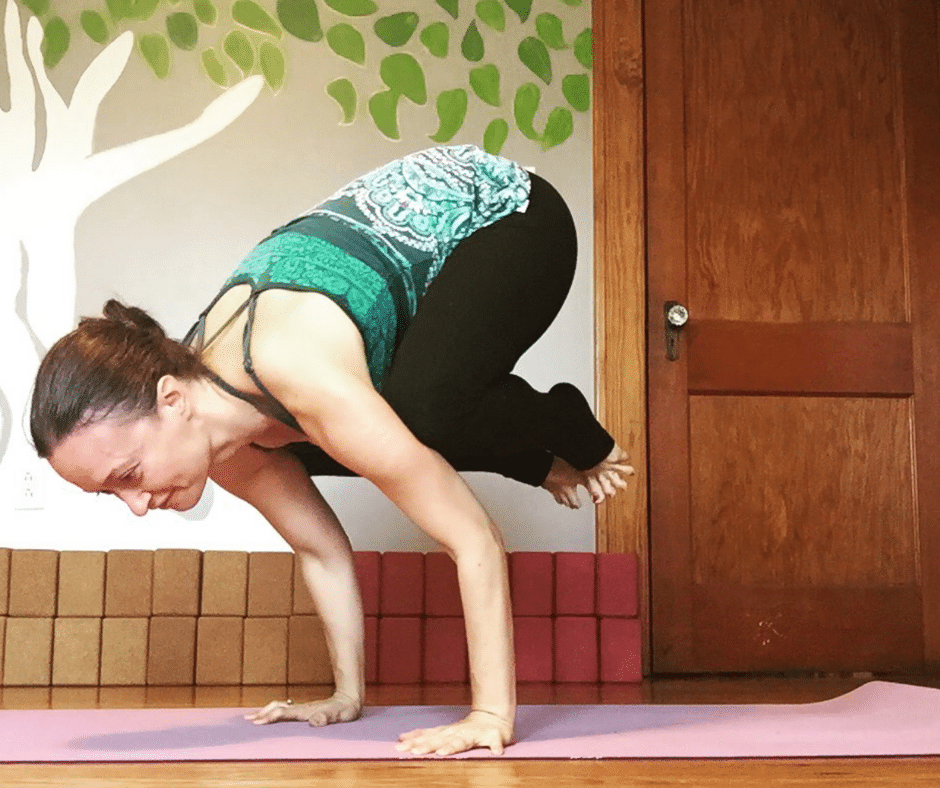
There are so many valuable aspects to challenging yourself on the yoga mat. Over time you gain strength and flexibility. Observing progress can be empowering and give you a sense of accomplishment and confidence.
And it can be so much fun to try new things and PLAY like maybe you did when you were a kid.
Right now I’m loving playing with Forearm Balance and Handstand and it’s bringing up ALL the memories of cartwheeling in my backyard as a little girl. (Something I am loving doing with my daughters these day, too!)
See also Is It Safe? Inversions During Pregnancy
But at some point these poses can also bring up something less joyful: Fear!
What do you do when you feel paralyzed by fear–the sweaty palms, knots in your stomach, can’t move kind of fear–when you hear your teacher calls out a challenging pose?
First, take a deep breath and remember that we ALL experience fear on our yoga mats. Then, know that your yoga mat is a safe space for exploration and observing, not just your body but your mind and emotional state, too.
Working through your fears in a safe, judgement-free zone will help you learn lots of different approaching for working through your fears in less than desirable circumstances. So, stick with it! It’s SO worth the effort.
I’m rooting for you!
Subscribe to my YouTube Channel here.
5 Tips for Approaching Fear in Yoga
1 – Use Support!
Try a wall or a prop that makes it seem less scary and more accessible.
Usually finding little wins, no matter how small, will help you gain confidence and set you on your way to overcoming even the most deeply seeded fear in yoga.
2 – Take small steps toward the pose to help you build skills, strength, and confidence slowly over time.
A little goes a long way.
It’s much more effective to slowly stretch your comfort zone than it is to hold your breath and “just do it.”
In my experience, you’re much more likely to hurt yourself when you do it this way–and then you’re back at square one, only MORE fearful. 😩
3 – Change it up.
Look for creative alternatives to the pose.
For example, if kicking up to Handstand at the wall is causing a stress response, why not try turning around and walking your feet up (belly to the wall instead of spine)?
Maybe Standing Split is more your speed, or the alternative where you’re engaging all the same muscles but lying on your back on the floor. If you do this, over time, you’ll be more skilled at all the elements of the posture, and maybe it won’t seem so daunting.
There’s never just ONE way to practice a pose and experience the benefits.
4 – Ask for help.
Believe me when I say this. Most yoga teachers LIVE for the moment a student asks them for tips after class. Yes, we like to help. But also… the chance to show off all the things we learned in our most recent training?!
I, for one, would LOVE to support you. Check out my live yoga class schedule here.
5 – Be patient.
Learning new tricks is fun. I can think of lots of reasons to work on a “goal pose.” But confetti doesn’t fall from the sky when you’ve finally figured out how to balance in Handstand in the middle of the room. Heck, you don’t even automatically get more Instagram followers! So take your time. Progress is made by consistently showing up again and again over a span of years, not weeks.
BONUS Tip: Be nice.
Most of all, be kind and loving to yourself when you’re making progress, and also when you’re not. Your worth has nothing to do with what fancy shapes you can make with your body or how good your photo looks when you do it.
The process of practicing a hard thing is always way more valuable than achieving it.
See also 5 Things Handstand Taught me about Marketing My Yoga Business.

Agree with all of them. Sometimes it’s embarrassing to ask for help but you really have to